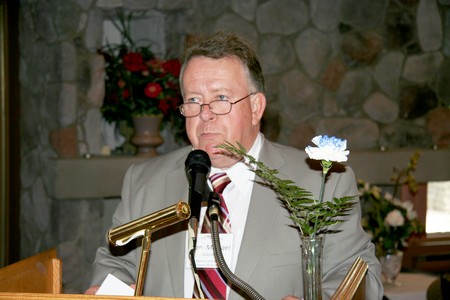 Michael Gravelle, Ontario Minister of Northern Development, Mines and Forestry, painted a rosy picture for the province's mining industry at the Ontario Mining Association's conference in North Bay, June 15th.
Michael Gravelle, Ontario Minister of Northern Development, Mines and Forestry, painted a rosy picture for the province's mining industry at the Ontario Mining Association's conference in North Bay, June 15th.
"The last decade has been a record-breaking one for Ontario," said Gravelle. "It has been one of best mining cycles in our history. At the same time, of course, the last couple of years have been tough, but we are now seeing encouraging signs of recovery."
Gravelle pointed to the two new gold mines that entered into production in 2009 - Brigus Gold Corp.'s Black Fox Mine in Matheson and St. Andrew Goldfields' Holloway Mine near Timmins. Both Brigus Gold and St Andrew Goldfields expect to produce 85,000 ounces of gold this year. The two operations combined, said Gravelle, have created approximately 280 jobs.
Also encouraging is the planned startup of commercial production from Lakeshore Gold's Timmins Mine in the fourth quarter of this year, Detour Gold's plans to commence mine development at its Detour Lake property 180 kilometres northeast of Cochrane, and Northgate Minerals' plans for commissioning of its Young-Davidson Mine late next year.
Diamonds
Gravelle also cited Ontario's burgeoning diamond sector consisting of De Beers' Victor Mine in the province's James Bay Lowlands, a new cutting and polishing operation in Sudbury and the Toronto-based Diamond Bourse of Canada.
Another bright spot on the horizon is the province's mineral-rich Ring of Fire region, also in the James Bay Lowlands. The Ring of Fire, said Gravelle, "is one of the most promising development opportunities in Ontario in more than a century."
Exploration in the region has already unearthed rich deposits of chromite, nickel, copper, and platinum group metals and more discoveries are anticipated as 30 exploration companies continue working the 31,000 claims registered with the province.
Leading the way in the Ring of Fire is Cliffs Natural Resources, which spent $240 million on the acquisition of Freewest Resources in January and a further $125 million to snap up Spider Resources, giving it control of the contiguous Big Thor, Black Label and Big Daddy chromite properties. Bringing the resource into production with the necessary processing facilities and transportation infrastructure is expected to generate billions of dollars in new investment and open up the region for further mine development.
"We want to work closely with everyone involved to make this happen because the Ring of Fire will be very significant for the Far North of Ontario," said Gravelle. "This will be a tremendous opportunity for jobs and growth, particularly for the Aboriginal people to get trained to work in extremely well-paying mining jobs and to be very much directly involved in the industry."
The Ministry of Northern Development, Mines and Forestry plans to have a Ring of Fire co-ordinator in place later this year to oversee the development of the region and to ensure that the project moves ahead in a timely and appropriate manner.
"Our rich mineral endowment, our business climate and our ongoing efforts to advance the province's standing in mineral development all contribute very strongly to Ontario's status as a preferred destination for major mining investments," said Gravelle.
The mines minister recapped a series of recent tax measures that will further boost the mining industry's fortunes, including the introduction of a blended value added sales tax and a planned cut in taxes for new business investments.
Tax relief
The introduction of the Harmonized Sales Tax in Ontario brings the province "in line with more than 140 countries that have a similar value added tax," said Gravelle. "The most significant tax reform in a generation" will save the province's manufacturing sector approximately $510 million annually. The harmonized tax replaces and blends together the federal government's value-added tax known as the GST and Ontario's non-value-added PST.
The mining industry will benefit from Ontario's plans to halve the marginal effective tax rate on new business investment - from 32.8 per cent in 2009 to 16.2 per cent by 2018, as well as the recently announced three-year Northern industrial energy rebate program which will reduce industrial electricity costs by 25 per cent for qualifying operations committed to energy efficiency and sustainability.
"The future of mining, I believe, is significantly brighter as a result of these initiatives and the measures we've taken," said Gravelle.
Mining Act
The minister pointed to the modernization of the province's Mining Act as a positive step that will help build a strong and stable future for the mining industry.
"We believe that the amendments to the Mining Act will solidify a foundation of consultation that's appropriate with the graduated impact of exploration and activity on the Aboriginal communities throughout the mining sequence."
The changes to the Act, he said, will create "a business environment conducive to sustainable mineral development and engagement with Aboriginal people."

.jpg;w=120;h=80;mode=crop)